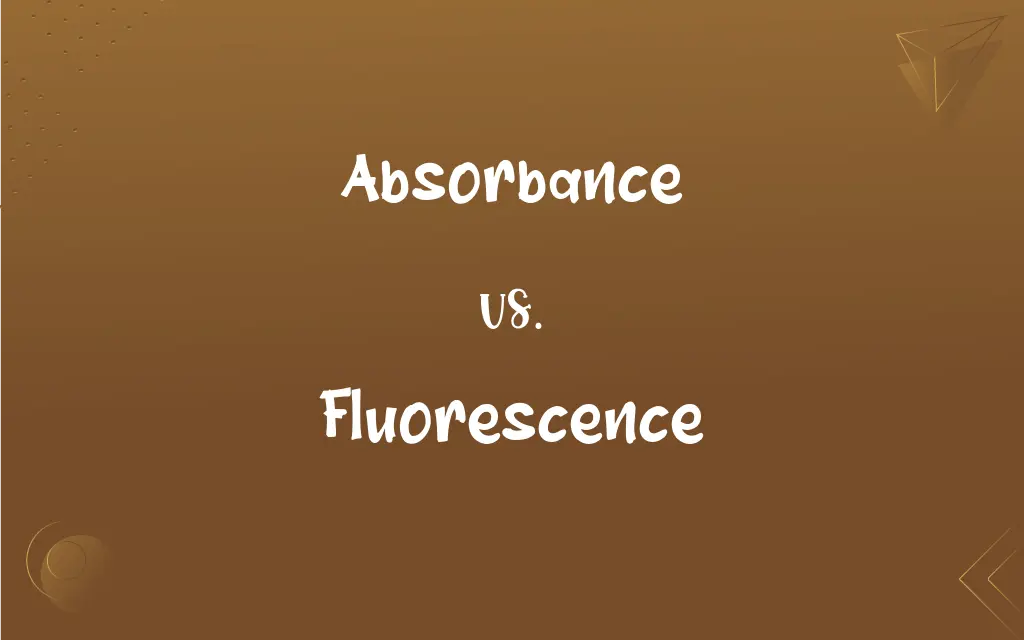Absorbance vs. Fluorescence: What's the Difference?
Edited by Aimie Carlson || By Harlon Moss || Published on January 29, 2024
Absorbance is the measurement of light absorbed by a substance, while fluorescence is the emission of light by a substance that has absorbed light.

Key Differences
Absorbance involves a substance absorbing specific wavelengths of light, reducing the intensity of light passing through it. Fluorescence, in contrast, occurs when a substance absorbs light and then re-emits it at a different wavelength, usually longer.
In absorbance, the amount of light absorbed is often used to determine the concentration of a substance. Fluorescence, on the other hand, relies on detecting the light emitted after excitation, which is also used for concentration analysis but with higher sensitivity.
Absorbance measurements do not involve any light emission from the sample; they only measure light loss. Fluorescence measurements are based on detecting emitted light, which can provide information about the environment of the fluorescent molecule.
The equipment for measuring absorbance is typically simpler and less expensive compared to fluorescence spectrometers. Fluorescence requires more specialized equipment to detect emitted light and differentiate it from the excitation source.
Absorbance does not require a substance to have fluorescent properties. Fluorescence, however, is specific to molecules capable of re-emitting absorbed light, which makes it a more selective analytical technique.
ADVERTISEMENT
Comparison Chart
Light Interaction
Involves absorption of light
Involves absorption and subsequent emission of light
Measurement Focus
Measures light reduction through a substance
Measures light emitted from a substance
Sensitivity
Generally less sensitive
Typically more sensitive
Equipment Complexity
Simpler spectrophotometers
Requires specialized spectrometers
Substance Requirement
No need for fluorescent properties
Requires fluorescent properties
ADVERTISEMENT
Absorbance and Fluorescence Definitions
Absorbance
Absorbance is a representation of the fraction of light absorbed by a substance.
The absorbance spectrum helped identify the unknown compound.
Fluorescence
Fluorescence is the emission of light by a substance that has absorbed light or other electromagnetic radiation.
The fluorescence of the mineral under UV light was stunning.
Absorbance
Absorbance quantifies how much light is absorbed by a material.
We used absorbance to determine the purity of our chemical sample.
Fluorescence
Fluorescence is the process of emitting light by a substance that has absorbed light of a different wavelength.
We used fluorescence to detect the presence of bacteria.
Absorbance
Absorbance indicates the capacity of a substance to absorb light at a specific wavelength.
The absorbance at 450 nm was critical for our analysis.
Fluorescence
Fluorescence is a photoluminescence form where a molecule emits light upon returning to its ground state.
The fluorescence spectra provided valuable information about the molecular structure.
Absorbance
Absorbance is the measure of the attenuation of light passing through a substance.
The absorbance of the solution increased as the concentration of the dye was raised.
Fluorescence
Fluorescence is the visible or invisible radiation emitted by certain substances as a result of incident radiation of a shorter wavelength.
Fluorescence microscopy is essential in cellular biology.
Absorbance
Absorbance is a logarithmic measure of the amount of light absorbed by a sample.
We plotted the absorbance against time to study the reaction kinetics.
Fluorescence
The emission of electromagnetic radiation, especially of visible light, stimulated in a substance by the absorption of incident radiation and persisting only as long as the stimulating radiation is continued.
Absorbance
(physics) A logarithmic measure of the amount of light that is absorbed when passing through a substance; the capacity of a substance to absorb light of a given wavelength; optical density.
Fluorescence
The property of emitting such radiation.
Fluorescence
The radiation so emitted.
Fluorescence
(physics) The emission of light (or other electromagnetic radiation) by a material when stimulated by the absorption of radiation or of a subatomic particle.
Fluorescence
The light so emitted.
Fluorescence
A luminescence emitted by certain substances due to the absorption of radiation at one wavelength, and the almost instantaneous re-emission of radiation at another, usually longer wavelength. The re-radiation stops almost as soon as the incident radiation is halted, thus distinguishing this phenomenon from phosphorescence, in which re-radiation of light may continue for some time after the incident radiation is halted.
Fluorescence
Light emitted during absorption of radiation of some other (invisible) wavelength
Fluorescence
Fluorescence is the rapid emission of light by excited molecules upon relaxation to their ground state.
The fluorescence marker helped in tracking the drug distribution.
FAQs
What is absorbance?
Absorbance is the measurement of the amount of light absorbed by a substance.
Is fluorescence more sensitive than absorbance?
Yes, fluorescence is generally more sensitive and can detect lower concentrations.
Can absorbance be used to measure concentration?
Yes, absorbance is commonly used to determine the concentration of solutions.
How is fluorescence different from absorbance?
Fluorescence involves the emission of light after absorption, whereas absorbance only measures light absorption.
What is the role of a spectrophotometer in absorbance measurement?
A spectrophotometer measures the intensity of light before and after passing through a sample to determine absorbance.
What is a fluorescence spectrum?
A fluorescence spectrum is a plot of the intensity of emitted light as a function of its wavelength.
Do all substances exhibit fluorescence?
No, only substances with specific fluorescent properties can exhibit fluorescence.
Can absorbance provide information about a substance's structure?
Absorbance can give insights into molecular structure based on light absorption patterns.
Is absorbance affected by the path length of the light through the sample?
Yes, absorbance increases with the length of the path the light travels through the sample.
Can absorbance occur without fluorescence?
Yes, absorbance can occur without fluorescence if the substance doesn't re-emit light.
What is the Beer-Lambert Law in the context of absorbance?
The Beer-Lambert Law relates the absorption of light to the properties of the material through which the light is traveling.
How does temperature affect fluorescence?
Temperature changes can affect the intensity and wavelength of fluorescence.
What applications use fluorescence?
Fluorescence is used in biochemical, medical, and environmental testing.
How does the wavelength of emitted light in fluorescence compare to the absorbed light?
The emitted light in fluorescence usually has a longer wavelength than the absorbed light.
How is fluorescence used in medical diagnostics?
It's used for imaging, detecting specific biomolecules, and diagnosing diseases.
Can absorbance be used to identify unknown substances?
Yes, by comparing absorbance spectra to known references, it can help identify substances.
What is the importance of the excitation wavelength in fluorescence?
The excitation wavelength is crucial as it must match the absorption spectrum of the fluorescent molecule for effective excitation.
What is an example of a practical application of fluorescence?
Fluorescent dyes are used in flow cytometry to identify and sort different types of cells.
What factors affect fluorescence intensity?
Factors include the concentration of the fluorescent substance, temperature, and the chemical environment.
Are there substances that absorb but do not emit light?
Yes, many substances absorb light but do not emit it, thus showing no fluorescence.
About Author
Written by
Harlon MossHarlon is a seasoned quality moderator and accomplished content writer for Difference Wiki. An alumnus of the prestigious University of California, he earned his degree in Computer Science. Leveraging his academic background, Harlon brings a meticulous and informed perspective to his work, ensuring content accuracy and excellence.
Edited by
Aimie CarlsonAimie Carlson, holding a master's degree in English literature, is a fervent English language enthusiast. She lends her writing talents to Difference Wiki, a prominent website that specializes in comparisons, offering readers insightful analyses that both captivate and inform.































































